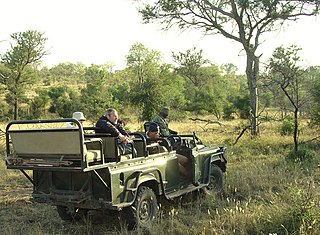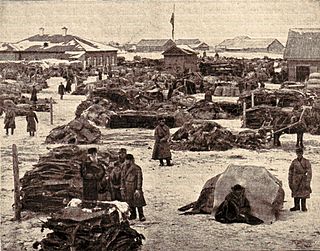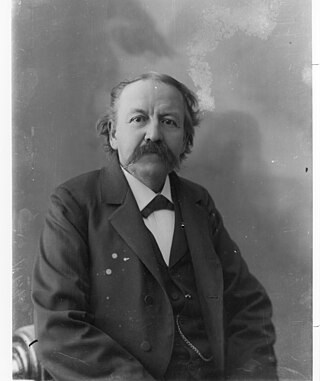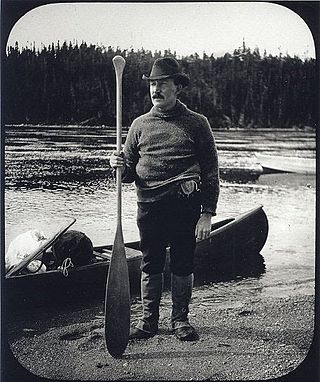
An adventure is an exciting experience or undertaking that is typically bold, sometimes risky. Adventures may be activities with danger such as traveling, exploring, skydiving, mountain climbing, scuba diving, river rafting, or other extreme sports. Adventures are often undertaken to create psychological arousal or in order to achieve a greater goal, such as the pursuit of knowledge that can only be obtained by such activities.

Robert Louis Stevenson was a Scottish novelist, essayist, poet and travel writer. He is best known for works such as Treasure Island, Strange Case of Dr Jekyll and Mr Hyde, Kidnapped and A Child's Garden of Verses.

James Smithson was a British chemist and mineralogist. He published numerous scientific papers for the Royal Society during the early 1800s as well as defining calamine, which would eventually be renamed after him as "smithsonite". He was the founding donor of the Smithsonian Institution, which also bears his name.

A safari is an overland journey to observe wild animals, especially in Southeast Africa. The so-called "Big Five" game animals of Africa – lion, leopard, rhinoceros, elephant, and Cape buffalo – particularly form an important part of the safari market, both for wildlife viewing and big-game hunting.

James Harrison Wilson was a United States Army topographic engineer and a Union Army Major General in the American Civil War. He served as an aide to Maj. Gen. George B. McClellan during the Maryland Campaign before joining Maj. Gen. Ulysses S. Grant's army in the Western Theater, where he was promoted to brigadier general. In 1864, he transferred from engineering to the cavalry, where he displayed notable leadership in many engagements of the Overland Campaign, though his attempt to destroy Lee’s supply lines failed when he was routed by a much smaller force of Confederate irregulars.

Joseph Plumb Martin was a soldier in the Connecticut Militia and Continental Army during the American Revolutionary War, and was mustered out as a 23-year-old Sergeant in a Sapper company. His published narrative of his experiences, re-discovered in the 1950s, has become a valuable resource for historians in understanding the conditions of a common soldier of that era, as well as the battles in which Martin participated.

Adventure travel is a type of niche tourism, involving exploration or travel with a certain degree of risk, and which may require special skills and physical exertion. In the United States, adventure tourism has grown in recent decades as tourists seek out-of-the-ordinary or "roads less traveled" vacations, but lack of a clear operational definition has hampered measurement of market size and growth. According to the U.S.-based Adventure Travel Trade Association, adventure travel may be any tourist activity that includes physical activity, a cultural exchange, and connection with outdoor activities and nature.

The Irbit fair was the second largest fair in Imperial Russia after the Makariev Fair. It was held annually in winter in the town of Irbit, trading with tea and fur brought along the Siberian trakt from Asia.

The genre of travel literature or travelogue encompasses outdoor literature, guide books, nature writing, and travel memoirs.
Daniel Willard Streeter, was an American hunter, adventurer and writer active in the 1920s, who lived in Buffalo, New York.

Elias Burton Holmes was an American traveler, photographer and filmmaker, who coined the term "travelogue".
Nathaniel Lande, born of Canadian parents, is a journalist, author, and filmmaker with a career spanning several decades. He is the author of ten books including Cricket and Dispatches from the Front: A History of the American War Correspondent, and was a creative force behind Time Inc. during his tenure.

Charles Austin Fosdick, better known by his nom de plumeHarry Castlemon, was a prolific writer of juvenile stories and novels, intended mainly for boys. He was born in Randolph, New York, and received a high school diploma from Central High School in Buffalo, New York. He served in the Union Navy from 1862 to 1865, during the American Civil War, acting as the receiver and superintendent of coal for the Mississippi River Squadron. Fosdick had begun to write as a teenager, and drew on his experiences serving in the Navy in such early novels as Frank on a Gunboat (1864) and Frank on the Lower Mississippi (1867). He soon became the most-read author for boys in the post-Civil War era, the golden age of children's literature.

Overlanding or 4WD Touring is self-reliant overland travel to remote destinations where the journey is the principal goal. Typically, but not exclusively, it is accomplished with mechanized off-road capable transport where the principal form of lodging is camping, often lasting for extended lengths of time and spanning international boundaries.

Elbridge Streeter Brooks was an American author, editor, and critic. He is chiefly remembered as an author of numerous works of fiction and nonfiction for children, much of it on historical or patriotic subjects. His byline for most of his writing was Elbridge S. Brooks.

William Pembroke Fetridge (1827-1896) was a travel writer, publisher, bookseller and periodicals distributor. He lived in the Boston, Massachusetts area and in Paris, France.
Chodsigoa is a genus of shrews in the tribe Nectogalini.

Dillon Wallace (1863-1939) was an American lawyer, outdoorsman, author of non-fiction, fiction and magazine articles. His first book, The Lure of the Labrador Wild (1905) was a best-seller, as were many of his later books.

Travelogues of Palestine are the written descriptions of the region of Palestine by travellers, particularly prior to the 20th century. The works are important sources in the study of the history of Palestine and of Israel. Surveys of the geographical literature on Palestine were published by Edward Robinson in 1841, Titus Tobler in 1867 and subsequently by Reinhold Röhricht in 1890. Röhricht catalogued 177 works between 333 – 1300 CE, 19 works in the 14th century, 279 works in the 15th century, 333 works in the 16th century, 390 works in the 17th century, 318 works in the 18th century and 1,915 works in the 19th century.
Travelogues of Latin America are published accounts describing Latin America and the Caribbean by foreign travelers from early Iberian conquest to the early 20th century. The Spanish and Portuguese monarchs' efforts to restrict non-Iberian's access to Latin America during the colonial era mean that most of the works published before 1800 were by authorized Spanish or Portuguese chroniclers, or European Catholic missionaries. However, the popularity of Prussian naturalist Alexander von Humboldt's twenty-one volume account of his travels in Latin America marked a turning point. Starting in the 1820s, most independent Latin American governments welcomed increased exchanges with European visitors, increasing the number of German, British, French, and U.S. travelogues published. Many foreigners were interested in economic opportunities available in Latin America. At least 394 travelogues describing Mexico were published between 1810 and 1910. For Brazil, European and U.S. visitors published at least 158 travelogues between 1800 and 1899.
















